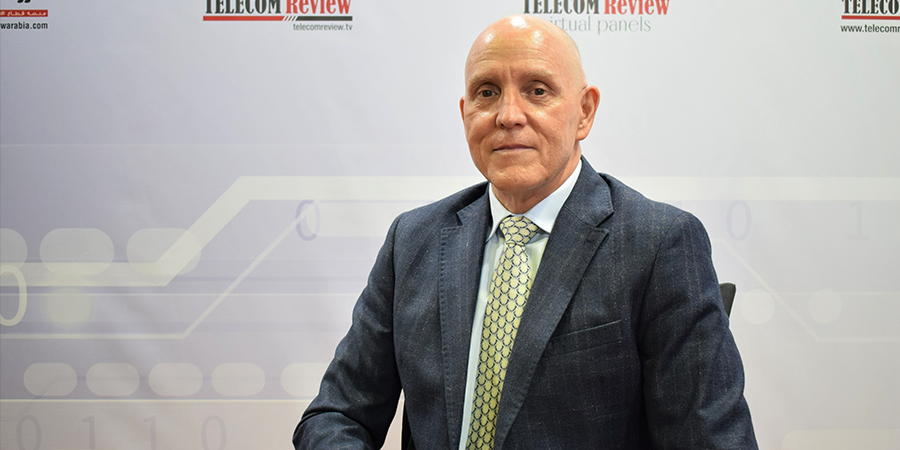Along the sidelines of GITEX 2021, Telecom Review secured discussion with Paul Scanlan, CTO of Carrier Business Group at Huawei, regarding digital transformation, ecosystem building, and wide-scale industry collaboration. Scanlan emphasized how Huawei supports telecom operators in enabling intelligent societies of the future. To achieve this vision, understanding technology and what it entails for specific industries are crucial to transforming and connecting everybody, and everything.
Huawei’s theme for GITEX this year is ‘Dive into Digital’. How is this technologically demonstrated in the Carrier Business Group?
In the Carrier Business Group, we are primarily responsible for providing technology solutions to the telecom operators. When we talk about diving into digital and how is that possible technology-wise, we really start with things like 5G. What 5G does, together with fiber and the other access technologies that Huawei has developed, is it allows you to connect everybody and everything.
That's terribly important, because to be digital, you need information that you can analyze. 5G and other access technologies collect data and transport it into the cloud, which makes it very flexible and efficient. This enables us to put AI-based algorithms around that data. It’s the algorithms that really do all the analytics, and that's really how we're able to provide more intelligent digital transformation solutions.
Facing a 5G-powered world, how would Huawei’s products and solutions keep up with the demands of building resilient and sustainable ecosystems?
When we talk about sustainability, it is all about building for the future. If we have a lot of growth, 5G supports growth much better than 3G and 4G as it is much more efficient. Huawei 5G products are about 30% lighter and less power-consuming. This is what we mean by heading towards sustainability.
If things are lighter, then they're also easier to install. Hence, costing less. This is the whole ecosystem from logistics to power consumption, making Huawei a lot more effective and efficient. And that's why we are recognized in the industry for supporting a greener world.
With an accelerated transformation toward an intelligent society, how can the telecom industry thrive further?
When we talk about an intelligent society, it absolutely involves the telecom network. In terms of connecting everybody, who does this best? The telecom operators. We supply the solutions to the telecom operators and they're the ones that provide the connectivity to industry.
Today, connected transport, healthcare, and manufacturing are all very good use cases that require low latencies and massive connections. That's what really drives this intelligent society. But first, you must have the connectivity, and that's what Huawei stands for — intelligent connectivity. Without connectivity, there is no data. With no data, you can't put anything in the cloud. When there's nothing in the cloud, you won’t be able to analyze anything. If we can enable telecom operators with the right type of technology that can bring the broadest bandwidth, consume the least power, and have the best capability in terms of connecting everybody, that enables more intelligent societies.
From the perspectives of business success and technological capabilities, how can 5G truly be achieved?
As a global community, we have visions for intelligent cities, education, and health, among other sectors. These are the targets. In almost all these scenarios, you need 5G, but you also need a significant amount of fiber. Because without fiber connectivity, 5G will not be as successful. We need all the base stations or the towers connected with fiber. So the first premise is always about connectivity — no connection means nothing is going to work.
On the other hand, there is also the economics of 5G deployment. Spectrum is terribly important. The more spectrum you can liberalize, then the better and more efficient 5G will be. What follows after efficiency and spectrum availability is collaboration. If you can share facilities, share things like the lamp posts, the power poles, the ducts, and make these things available and accessible very inexpensively, then these all contribute to the ability of a telecom operator to roll out 5G networks very rapidly.
Why is collaboration crucial for CSP and enterprise business?
Looking more closely at the use cases, there are different types of opportunities for collaboration. For this to happen, we need digital transformation. In the health industry, for example, there’s sometimes a scenario of having only a few specialists available to treat many. In manufacturing, there’s always a push to improve the quality and productivity of the workers. In education, we have excellent teachers, and now we want to teach and train the whole population. All of these three use cases show how you take one to many and drive efficiency through digital transformation.
In each of these cases, transformation cannot be done just by a telecom operator, or just a single company like Huawei. We need collaboration. We need different industry sectors to understand what technologies like fiber, 5G, cloud, and AI can bring to their businesses. We also need industry partners to understand what these technologies can really do. For us, it's not about building a tower and selling SIMs; it's about understanding the enterprise very deeply and providing solutions to industry challenges. This builds a shared understanding and helps to support conversation on issues such as spectrum allocation, as just one example.
Ultimately, we need collaboration between governments, enterprises, and multiple ecosystem players such as system integrators, network providers, and developers. Only then can we all work for shared success across all industries.









